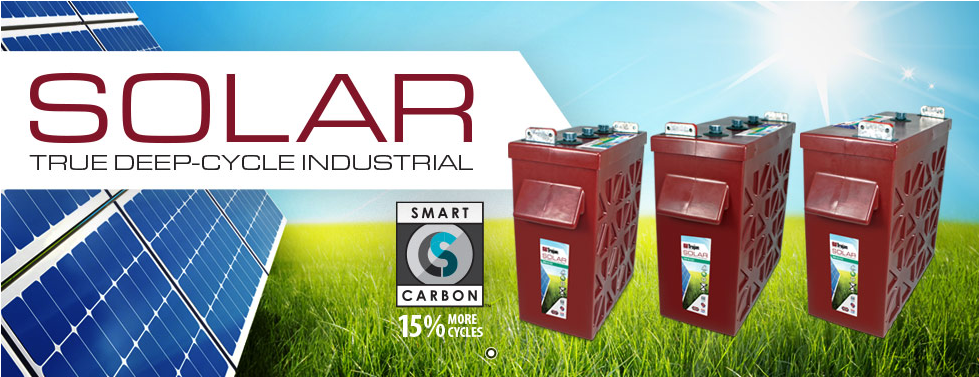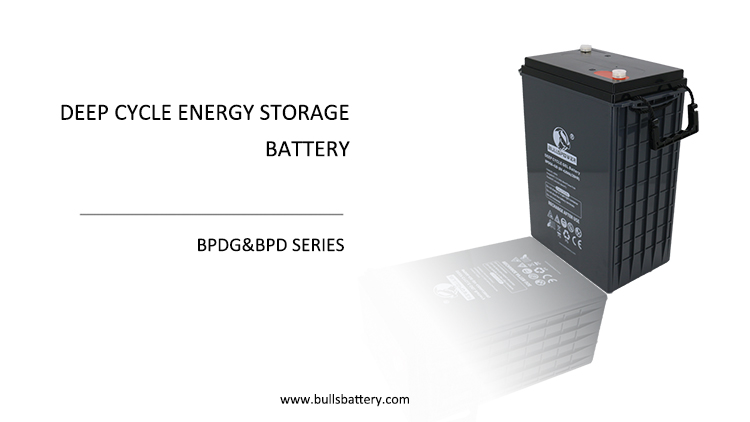DEEP CYCLE BATTERIES INTRODUCTION
|
SEALED DEEP CYCLE BATTERIES Deep Cycle Batteries used in renewable energy (RE) systems are different from car batteries and that difference is critical. RE systems by nature are cyclical: energy is captured and stored, then later consumed, in a (usually) regular. For example, in a battery-based solar electric system, the energy produced daily by the solar panels is stored in the battery bank, which is then used by loads at night or on not-so-sunny days. This repetitive process subjects the batteries to a slow, daily charge and discharge pattern.Car batteries are not meant to be used in this way. They can release a great deal of their stored energy at once, to start the engine, then they immediately receive a rapid recharge from the car’s alternator. They’re not meant to recover their charge slowly, as would happen in a solar electric system. They’re very impatient that way! In fact, a car battery in a RE system would quickly die and need to be replaced. Deep cycle batteries, on the other hand, can be gradually discharged by as much as half of their capacity and will patiently await gradual recharge. When properly maintained, a deep cycle battery can last four to 10 years. There are two divisions and three main types of deep cycle batteries used in RE systems. The divisions are flooded and sealed batteries. Flooded batteries use a fluid electrolyte, have ports to access their cells’ fluid reservoirs, and require maintenance (adding fluid). Sealed batteries use non-fluid electrolyte contained in inaccessible cells. There’s only one flooded type: flooded lead-acid batteries. Sealed batteries include Absorbed Glass Mat (AGM) batteries and gel cell batteries.
FLOODED LEAD-ACID (FLA) DEEP CYCLE BATTERIESFlooded deep cycle lead-acid batteries (FLA), also called “wet cells”, are commonly used in solar, wind and hydroelectric renewabl energy systems. They are often the least expensive type of deep cycle battery and can last the longest. They also come in a wide range of sizes. In FLA batteries, a sulphuric acid solution is the which reacts with the lead plates in the cells to produce electricity. When FLA deep cycle batteries are recharged, electrolysis occurs, producing hydrogen and oxygen gases in a normal process called “outgassing”. These gases (hydrogen and oxygen) may escape the cells through the filler/vent caps, creating two problems: the fluid loss means that the fluid level in the battery goes down, potentially exposing the normally “flooded” lead plates—not a good thing. So using FLA batteries in your system means that you are committed to regularly monitoring and maintaining them by adding distilled water to each cell as needed. Water Miser vent caps can help prevent some moisture escape, thus reducing watering frequency. The other problem is the presence and accumulation of explosive gases. Hydrogen and oxygen gases are extremely dangerous and must be properly vented—to the outside air. So it’s clear that with FLA batteries, battery maintenance is an essential part of system maintenance.
One great advantage of sealed deep cycle batteries is that they can be placed in any orientation: upright, on their sides, and, in some cases, even upside-down. In a sealed battery, the electrolyte is suspended in either an absorbed glass mat (AGM) or in a gel. Sealed deep cycle batteries cost more than flooded lead-acid batteries and don’t last as many charging cycles; however, they are the preferred choice for applications requiring frequent battery handling, or where the system needs to be left unattended in a remote location. Like FLA batteries, sealed batteries have vents to allow hydrogen to escape when necessary, though this should not normally occur. The difference is that because the batteries are sealed, there is no way to replace the escaped moisture by adding water to the cells; that’s why a sealed battery won’t last as long as an FLA battery. Gel cell batteries have traditionally been a bit more expensive than AGM batteries; however, they have the unique advantage of performing better in very cold temperatures or in very deep-discharge applications and inherently they require less maintenance, since you cannot refill the electrolyte levels. On the other hand, charging them can be more delicate. If you overcharge them, the batteries will off-gas and permanently remove water suspended in the gel or glass mat (since distilled water cannot be re-injected into sealed batteries). WHICH DEEP CYCLE BATTERY TYPE IS RIGHT FOR YOUR APPLICATION?In most cases, FLA batteries are an excellent choice for RE systems because of their cost-effectiveness, particularly for those systems which require a lot of energy storage. But FLA batteries do require maintenance! Regular monitoring and maintenance will ensure your system functions properly and your batteries live a long, healthy life. On the other hand, if you’re using the deep cycle batteries in a remote area where regular maintenance is not possible, sealed batteries will be a better option. Furthermore, sealed batteries conform to situations with space constraints that require you to store your batteries in unusual orientations or where venting is not possible. One of the main advantages of sealed batteries versus FLA batteries is increased ease of transportation. Sealed deep cycle batteries can be shipped by air (weight permitting) but FLA batteries are often classed under “hazardous materials” rules, which restrict shipping options. The U.S. Post won’t ship your FLAs! All batteries are sized based on their nominal voltage and (Ah) of storage. Classification systems include battery “groups”, but listings by voltage and ampere-hours capacity are commonly available from manufacturers as well. For an off-grid system, the of the battery bank voltage must match that of the solar array unless you are using an MPPT charge controller that can accept a higher input voltage than the battery bank voltage. Available sizes in both flooded and sealed batteries vary greatly. The smallest batteries hold less than 20 Ampere-Hours (Ah); the largest approach 2,000 Ah of storage. Usually, these very large batteries are only 2 volts each. If you want to use them in a 48-Volt system, you will need 24 of them, wired in series. Such large batteries could weigh 200-300 pounds or more. Often size and weight constraints affect the final battery choice. Be sure you've got the equipment and space to deal with such oversized batteries before you order them. See our solar and deep cycle batteries selection to see a sample of the deep cycle batteries BULLSPOWER offers. |















